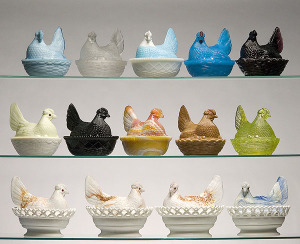Indiana Glass Company – Memories and Popular Patterns
The early history of the companies and operations which became the Indiana Glass Company are confusing, convoluted and not terribly well documented!
Indiana Glass Company of Dunkirk IN, originally a part of Beatty-Brady Glass Company which was founded by James Beaty and George Brady in 1895, is known for some of its unique products and patterns. During this very early time, all products (the likes of glass lamps, vases and glass materials for domestic use) were hand blown. In October 1899 the partners sold their plant to the National Glass Company, which was a large conglomeration of nineteen different glass companies. Competition was keen in the glass making business, so these businesses pooled their resources to survive.
A National Glass Company man named Frank Merry was sent to head the Dunkirk plant, after this merger. Eventually, Frank found he wanted to run a company of his own and he leased the local plant of National Glass in Dunkirk. A few short years later, when the National Glass Company went into receivership after the 1907 “Banker’s Panic,” Frank had put himself in a position, along with a group of other businessmen, to purchase the Dunkirk plant and form the Indiana Glass Company. This acquisition made Indiana a leading producer of pressed and blown glassware at the time. Frank Merry was president of the new company between 1909 and 1931 and in the early 1920s the company had annual sales of over $1,250,000 and employed 550 people.
The Indiana Glass Company was officially formed in 1907, according to an early Company letterhead.
Popular Patterns of The Early Indiana Glass Company Years :
Produced while Indiana was a part of National Glass, starting from 1900 to 1930 (also known as “Early American Press Glass”) are the following patterns :
Horsemint
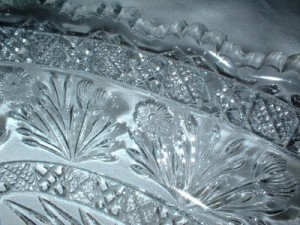
Bethlehem Star
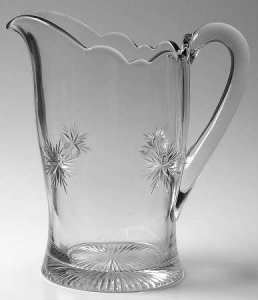
Panelled Daisy
Bird and Strawberry
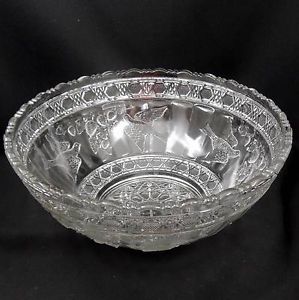
Darling Grape
Silver Anniversary
Ferris Wheel (also known as Ruby Star)
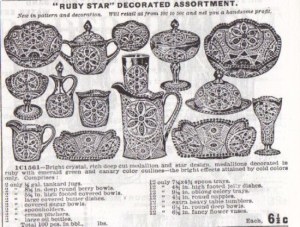
Garden Pink
Late Butterfly
Shooting Star
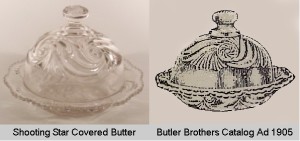
Indiana Glass Company and Depression Glass
While Indiana Glass is believed to be the longest producer of “Goofus Glass” – which is a whole other story that you may like to read about at Wikipedia – in these pages we want to know about the Indiana Glass Company’s involvement with Depression Glass.
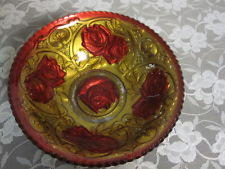
The story begins in 1923 when Indiana Glass introduced a pattern of glassware called Avocado, which is considered to be the very first Depression Glass Pattern. Made for 11 years in four colors: green, pink, crystal and white milk glass, it is an Art Nouveau pattern luncheon and serving set comprised of 16 pieces and it is a great favorite among Depression Glass collectors.
Popular Patterns of Indiana Depression Glass:
Frosted Black – Produced in 1915, this pattern was a bit ahead of its time. Bright colours in intricate, block like patterns adorned the pieces. Common colours were crystal, light pink, uranium-yellow and light green.
Sweat Pear (Avocado) – Produced from 1923 – 1934, his was one of the first patterns created for genuine Depression glass. A couple of pairs atop a pile of leaves was the signature design in this pattern, and was of course, originally green. Other distinctive colours were produced as well, however, such as crystal and pink. The pattern was also produced on milk glass.
Horseshoe – also known as pattern No. 612. Produced during the Great Depression era of 1925 to 1940.
Bananas – Produced during the Great Depression era of 1925 to 1940.
Cracked Ice
Sandwich – “sandwich” pieces often had flowers in the middle surrounded by adornments. Scrolls, floral patterns and even dots could be seen around the centre.
Indiana Custard – Pieces often had a vine like pattern around the edges
Pyramid – also known as pattern No. 610. Produced during the Great Depression era of 1925 to 1940.
Hen on a Nest – Produced in the 1930s, these pieces were shaped like beaded hens sitting on patterned nests.
Lorraine – Also known as pattern No. 615, this pattern was produced in 1929. This is one of the most high demand Indiana Glass pieces, adorned with floral designs.
Pineapple and Floral – also known as pattern No. 618. Produced during the Great Depression era of 1925 to 1940.
Old English – Produced during the Great Depression era of 1925 to 1940.
Tea Room – Produced during the Great Depression era of 1925 to 1940.
Fewer New Glassware Patterns Apparent During Wartime :
Like most glass making companies, for Indiana Glass Company, with the arrival of World War II came new priorities. Companies began to shift from pleasing the consumer to pleasing the country, and in an effort to play their parts in saving the world, they made some changes. Instead of producing fancy place settings for the common family, the glass companies began making things such as automobile headlights to use both at home and at war.
But the beautiful glass wasn’t forgotten in times of war. Shortly after the war ended, demand resumed, and restaurants began demanding a recent innovation: heat resistant milk glass. The glass was soon a staple in 1950s diners, and is still considered by many today to be a symbol for its time. In the United States, air conditioning was quickly becoming increasingly popular in the 1950s, and teenagers would flock to the diners for gatherings on hot afternoons, creating the all American image of the 50s diners that so many replicate today.
Popular Classic Glass (Produced from 1940 to 1970):
Christmas Candy
Teardrop
Daisy and Button
Orange Blossom
Garland
Magnolia
Wild Rose
Park Lane
Soon, however, demand began to slow for Indiana Glass Company, as it did for many in the industry shortly after their “big boom.” A few companies experienced continued interest that remained reliable, and those companies typically absorbed the ones that crashed. In 1957, Indiana became part of Lancaster Glass Company, and then became a part of a sister company, Colony Glass. The company continued to produce pieces until 2002, after the bankruptcy of a major seller at the time, Kmart.
You may like to view this informative and moving video :

